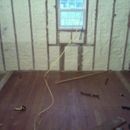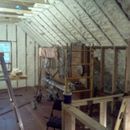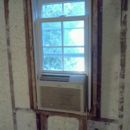Spray foam roof and vapor barrier
I have a Cape Cod style house that we had the roof sprayed with Open Cell foam. We plan to finish off the upstairs for living space. My question is that If we plan to use liquid vapor Barrier primer/paint do I need to paint all the foam, or can I get by with just spraying the drywall only. Do I need to spray behind the knee walls or will the drywall on the knee walls be sufficient? We do live in central Wisconsin.
GBA Detail Library
A collection of one thousand construction details organized by climate and house part













Replies
Dave,
Honestly, I don't have enough experience to answer your question.
Using open-cell foam for this application in your climate is risky, because of the chance that the roof sheathing will get damp. Installation of gypsum wallboard painted with vapor retarder paint is an adequate solution to the problem. My guess is that you can get away with ignoring the area behind the kneewall, but that's just a guess.
If it were my house, I would use closed-cell spray foam (too late for that) or would install drywall to cover the spray foam behind the kneewall, and I would paint the drywall with vapor-retarder paint. (Of course, it would have been easier to do that work before you built the kneewall.) The reason I would do that is that it would help me sleep at night.
All open cell foam is going to be too vapor permeable without the vapor barrier paint.
Applied to sheet rock vapor barrier latex performs at about 0.5 perms, which is fine.
According to the folks at Building Science Corporation, vapor barrier latex applied directly to the foam comes in at about 5 perms.
That is ~10x as permeable (same stuff, different substrate), which is kinda marginal, but WAY better than nothing. An overcoating of 1" of closed cell foam onto the open cell stuff behind the kneewall would reduce the permeance to about 08-1.2 perms, which would be better than 5 perms.
Unless the kneewall can be made air-tight to the mini-attic behind it, painting the kneewall gypsum with v.b. latex won't help a whole lot, but it won't hurt.
If the roof decking is t & g planking the risk of developing problems with only v.b. latex directly on foam are low. If the roof decking is OSB it's higher, but still manageable if you keep the interior relate humidity at no more than 35% in winter.
See figures 9, 10, 11 and the associated verbiage regarding spray-applied vapor retarders vs. 2-perm vapor retarders in this document :
http://www.buildingscience.com/documents/bareports/ba-1312-application-of-spray-foam-insulation-under-plywood-and-osb-roof-sheathing
So if I am understanding everything here, my best bet will be to open up the knee wall and shave the foam down and put up drywall and then paint? Will it matter how thick the drywall is behind the knee wall? I will assume that I would need to put on 2 coats. And if I do behind the knee wall I shouldn't need to paint the drywall that will be put on the knee wall afterwards. Would using Poly be a alternate solution to all this, or would I need to tape all joints and seal all outlets and make the attic space air tight? I really want to do whats best without having to re-coat with closed cell, not in the budget.
Dave,
Q. "Will it matter how thick the drywall is behind the kneewall?"
A. No.
Q. "Would using poly be a alternate solution to all this, or would I need to tape all joints and seal all outlets and make the attic space air tight?"
A. I don't recommend the use of interior polyethylene. Since you have chosen to install vapor-permeable spray foam, there are times when inward drying will be useful. Vapor-retarder paint is fine; you can install a smart retarder like MemBrain if you want, but you really shouldn't install interior polyethylene.
It always makes sense to pay attention to airtightness. The spray foam makes a fairly decent air barrier, as long as it was conscientiously installed. You don't have to pay attention to airtightness when you install finishes on your kneewall, though, since the kneewall is on the interior side of your air barrier.
With AC in that room you will be fine as to moisture. We built two homes with open cell spray foam prior to all the fuss about moisture. We sprayed foam with vapor paint. All is fine. The home does not have a humidifier. It does have AC and a basement dehumidifier.
Moisture uncontrolled is the problem, not the foam.
Polyethelene anywhere in the stackup would only increase the risk of problems. Either use half-perm "vapor barrier" latex on the gypsum that directly covers the foam, or directly on the foam itself as AJ suggests. The performance of half-perm latex applied directly to the foam is about 5 perms rather than it's rated permenace, but that will be good enough in MOST situations.
If you have the budget for MemBrain (much cheaper than an inch of closed cell) it would be a more resilient/lower solution (under all of it, including the cathedralized ceiling) than half-perm latex, but the latter isn't bad.
Moisture uncontrolled is the problem, not the foam./C
Having and using air conditioning and it is just about impossible to have any moisture issues with your build.
Next question, will having a full bathroom upstairs change everything? We have a dehumidifier in the basement, central air and a window AC unit upstairs. The bathroom will have a vent fan in it.
Also, with the VB primer, does it matter what brand, we have a gift card for Menards and they do have a VB primer.
bathroom moisture definitely needs to be controlled. Buy the vapor barrier paint spray the foam and spray the drywall that you put up.
the key will be to use the fan in the bathroom and to use the air conditioner.
IMO you will have no troubles. my 2 builds have had absolutely no moisture problems.